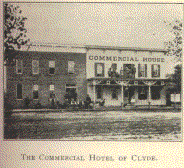 THE COMMERCIAL HOTEL OF CLYDE. |
Cattauraugus county, New York, is the birthplace of Mr. Wilkes. His paternal grandfather was one of the thirteen men who came over with LaFayette during the Revolutionary war; he was a musician. The Wilkes are of French origin and their advent into America dates from that time. They settled in Connecticut. In 1853, Mr. Wilkes began his career by going to New York City and working on the Crystal Palace which was being erected for the Word's Fair, and had the subordinate management of the arcade. In 1854, he came to Chicago where he railroaded in various capacities; was conductor of a passenger train for four years. During his residence in Chicago a company was formed among the railroad men for duty in the Civil war, but Mr. Wilkes could not pass muster. He subsequently accepted a position as traveling salesman and considered Chicago his home until after the big "Chicago Fire." Thinking the city would never rebuild, he turned his attention in the direction of Kansas, establishing the first hotel of any consequence in Belleville. From there he went to Washington, Kansas, and later to Cuba, Kansas, where he engaged in the mercantile business, at the same time owning a farm sixteen miles north of Clyde. He sold these interests in 1878 and enacted a good deed for Clyde when he opened a hotel with such excellent accommodations.
Mr. Wilkes was married in 1858, to Susan Lyman, who died January 23, 1864, leaving one child, a son who died one year later. In 1866, he was married to Eliza J. Faroll, a young woman of Irish birth who came to America in her childhood. By this marriage seven children were born, three of whom are living; George H., Jr., the present manager of the hotel (his family consists of a wife and three sons, Earl and Walter, two handsome and remarkably bright little fellows of ten and eight years, respectively, and Dick, aged one and one-half years); Edward J., of Kansas City, and a daughter, Courtney Grace. Mr. Wilkes is a Mason of twenty-eight years standing; a Knight Templar, Blue Lodge, and a Shriner. He is a democrat politically, and a member of the city council. He is a member of the Baptist church.
Mr. Wilkes has in his possession one of the rarest and most extensive collections of United States and foreign coins owned by any one individual in the state. The author is indebted to Mr. Wilkes for the following description:
"In this country, where evervthing is comparatively new, anything old or antique always attracts great attention. Large sums are paid for old furniture, such as andirons, candlesticks, spinning wheels, crockery, clocks, glassware, old arms, books and paintings, and recently old coins have been added. The local newspapers often publish long editorials about some curious coin. This is of what I want to speak. There are but few people who are posted on this subject and very few who know when the first coins were issued or what denomination it was. The first authorized coin by congress, as near as I can find out, was the Franklin cent, coined in 1787. This is a very curious piece of work having on one side the rising sun and sun-dial with the word "Fugio," meaning Franklin, and date; under the sun-dial these words: "Mind Your Business." On the reverse side it has thirteen links connected together, with this inscription: "We are one United States," making a very neat and interesting study. About that time there were quite a number of pennies of Washington, the most of which were struck in England, but they had nothing to do with the United States, although they were used as money and were called Washington coins and tokens. Of these there was a great variety and it would take too much space to attempt to describe all of them. There were a great number of miscellaneous coins in circulation until congress authorized the coinage of silver and copper coins, which was about 1792, when the act of April 2d authorized the coining of one-half pennies, weight one hundred and thirty-two grains. Weight changed, act of January 14, 1793, to one hundred and four grains, and act of March 3, 1795, to eighty-four grains. Coinage commenced in 1793, and discontinued in 1857 of this denomination; authorized act of July 6, 1787, caused to be coined for the United States by James Jarvis, of New Haven, Connecticut, the so called "Fugio" or Franklin cent; the regular large copper cents were authorized act of April 2, 1792, coinage commenced in 1793 and discontinued in 1857, there were none coined in 1815. Authorized act of February 21, 1857, to coin nickle cents, seventy-two grains, regular coinage commenced in 1857, a few were coined in 1856, coinage discontinued in 1864. The bronze cent comes next authorized April 22, 1864, weight forty-eight grains. Two cent bronze, act of April 22, 1864, weight ninety-six grains, discontinued in 1873. Three cent nickle, act of Marcll 3, 1863, weight thirty grains, discontinued 1873. Five cent nickle, act of May 16, 1866, weight seventy-seven and sixteen hundredths grains, coinage commenced in 1866. This is a short sketch of all the coins except the silver and gold issues of the United States."
![]()
Transcribed from E.F. Hollibaugh's Biographical history of Cloud County, Kansas biographies of representative citizens. Illustrated with portraits of prominent people, cuts of homes, stock, etc. [n.p., 1903] 919p. illus., ports. 28 cm.
